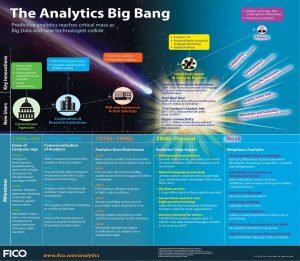Predictive Analytics: Your Magic 8 Ball

Predictive Analytics – The New Magic 8 Ball
I remember when I was a kid and a popular toy that everyone loved to play around with was the Magic 8 Ball. You would ask it a multitude of yes or no questions to get its prediction for the future.
It is certain. Outlook Good. Don’t Count on It. Better Not Tell you Now. These were just a few of the answers from the “wise” ball with a floating icosahedron (20 faced) inside. I’m sure we have all had times in our life personally or professionally where we wish we had a “Magic 8 Ball” to guide us through life.
In a sense, we do have some tools out there that can help us forecast for the future which brings in the idea of Predictive Analytics. A tool that has actually been used for centuries without many of us knowing about it. In your everyday life, I’m sure you could find at least a few ways in which predictive analytics is used. From ads that come up to predict your future shopping habits to the increase or decrease of your credit score.
What is Predictive Analytics?
There are a few definitions out there but most define it as the following:
Predictive Analytics is the practice of extracting information from existing data sets in order to determine patterns and predict future outcomes and trends.
Predictive Analytics can not tell you what will definitively happen in the future but serve as a guide on the odds or risks of future events or occurrences. The accuracy and usability of the forecast is highly dependent about on the level of data and the quality of assumptions.
Often the unknown event of interest is in the future, but predictive analytics can be applied to any type of unknown whether it be in the past, present or future. For example, it can be used after a crime has been committed or after credit fraud has occurred. The core of predictive analytics relies on capturing data from past occurrences and using that data to predict the unknown outcome.
History of Predictive Analytics
Some will say that Predictive Analytics have been around since the 1940’s but others believe that it started back in 1689. A company you may have heard of, Lloyd’s of London, began the process which we know call underwriting. During this time period, shipping and trade was primarily conducted by traveling the seas.
Financial bankers would accept risk on a given sea voyage in exchange for a premium which was written on a Lloyd’s slip. Lloyd’s of London would obtain information regarding shipping news. This data would help forecast the risk of a particular sea voyage.
As I mentioned, others feel it started in the 1940’s when governments started using computational models. See the infographic below on the evolution of Predictive Analytics.

With the advent of AI, more data can be processed than ever before since it can operate without human intervention. The future of predictive analytics is endless. In fact, according to a report issued by Zion Market Research, the global market for Predictive Analytics is expected to reach approximately $10.95 billion by 2022. This is growing at a company annual growth rate of around 21 percent between 2016 and 2022.
How is Predictive Analytics Used Today?
There are many industries and professions that are currently using Predictive Analytics. Companies are trying to seek an edge in our very competitive market where they are fighting to survive and withstand long-standing problems.
Here are just a few of today’s Applications:
Automotive: Driver Assistance Technology where sensor data is analyzed to build assistance algorithms.
Aerospace: Using it to Improve aircraft up-time and reduce maintenance costs.
Child Care: Flagging high risk cases for potential child abuse.
Energy Production: Forecasting Electricity price and demand.
Financial sector: Credit risk models, identifying the most effective collection agencies, fraud protection, underwriting and project risk management are just a few of the uses.
Industrial Automation and Machinery: Predicting machine failures.
Law Enforcement: Crime Trend Data is used to define neighborhoods that may need additional protection at certain times of the year.
Marketing: Through data analysis marketers can predict customer buying habits, determine customer life cycles, and mitigate issues that could cause a loss of customer. By analyzing a customers’ spending, usage and other behavior this can lead to cross sales of additional products. Marketers are also using analytics to help identify the most effective combination of marketing tactics to target a given customer.
Medical: 93 percent of Healthcare Executives have stated that predictive analytics is important to their business’ future. A 2017 Society of Actuaries report discovered that over half of healthcare executives (57%) already using predictive analytics believe that the technology will help them to save 15 percent or more of their total budget over the next five years. It is currently being used to determine which patients are at risk of developing certain conditions like diabetes, asthma, heart disease and more.
Predictive Analytics and IT
IT Professionals around the world are constantly looking for tools to save them from a plethora of challenges. Outages, slow response time and network attacks are just a few of the problems impacting the IT world. Predictive Analytics can come in to help with some of these issues.
HPE’s InfoSight and Aruba’s NetInsight are solutions that are using predictive analytics. These tools can provide recommendations, real-time detection, accelerated troubleshooting and more for your network, servers and storage. Contact Zunesis for a demo on how these solutions work.
Will Predictive Analytics Continue to be used in the future? All Signs Point to Yes!
Categories
Search
Blog Categories
Related Resources
Archives
- July 2024
- June 2024
- May 2024
- April 2024
- March 2024
- January 2024
- October 2023
- September 2023
- August 2023
- July 2023
- June 2023
- May 2023
- April 2023
- March 2023
- February 2023
- January 2023
- October 2022
- July 2022
- June 2022
- May 2022
- April 2022
- March 2022
- February 2022
- January 2022
- December 2021
- November 2021
- October 2021
- September 2021
- August 2021
- July 2021
- June 2021
- May 2021
- April 2021
- March 2021
- February 2021
- January 2021
- December 2020
- November 2020
- October 2020
- September 2020
- August 2020
- July 2020
- June 2020
- May 2020
- April 2020
- March 2020
- February 2020
- January 2020
- December 2019
- November 2019
- October 2019
- September 2019
- August 2019
- July 2019
- June 2019
- May 2019
- April 2019
- March 2019
- February 2019
- January 2019
- December 2018
- November 2018
- October 2018
- September 2018
- August 2018
- July 2018
- June 2018
- May 2018
- April 2018
- March 2018
- February 2018
- January 2018
- December 2017
- November 2017
- October 2017
- September 2017
- August 2017
- July 2017
- June 2017
- May 2017
- April 2017
- March 2017
- February 2017
- January 2017
- December 2016
- November 2016
- October 2016
- September 2016
- August 2016
- July 2016
- June 2016
- May 2016
- March 2016
- February 2016
- January 2016
- December 2015
- October 2015
- September 2015
- August 2015
- July 2015
- June 2015
- May 2015
- April 2015
- March 2015
- February 2015
- January 2014
- February 2013




